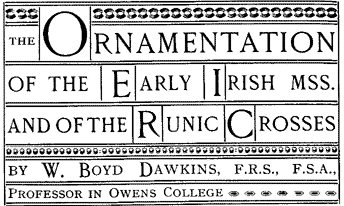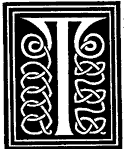
[From Manx Note Book vol 3, 1887]

 HE
DERIVATION OF THE
HE
DERIVATION OF THE
INTERLACING OR ROPE - PAT
TERN IN THE IRISH MSS., AND
ON THE RUNIC CROSSES, IS SO
IMPORTANT IN ITS BEARINGS
ON THE EARLY HISTORY AND
ART OF NORTHERN AND WEST
ERN EUROPE, THAT I AM obliged, with reluctance, again to join issue
with Canon Taylor, both on matters of fact and on matters of opinion.
The question between us as to its derivation from Germanic
tribes, according to me, or of its purely Celtic and Irish origin,
according to him, narrows itself ultimately into the further
question: Did the Irish Christians of the days of St. Columba,
and afterwards, obtain it from their intercourse with the Germanic
conquerors of the Roman empire and use it for the ornamentation of
their M SS., as I have pointed out in my communication to THE MANX
NOTE BOOK,* or did they invent it themselves, and introduce it among
the Germanic tribes of Britain and the Continent, as Canon Taylor
holds ? + The answer is to be found in the fads of
contemporary history coupled with the results of modern
archaeological inquiry. " It cannot be pretended " (writes Canon
Taylor)* that Germanic influences could have penetrated into Ireland
sufficiently early to allow of the interlacing or rope pattern of the
Irish MSS. (which are not earlier than the seventh century), being
borrowed from a Germanic source. The following facts take this point
out of the region of pretence into the sober light of history. The
Christianity of St. Patrick, A.D. 432,+ and St. Columba, A.D .
521-597, with its peculiar Eastern tinge, was itself derived from
Gaul, which was in those times in the hands of the Germanic peoples,
Burgundians, Franks, and Goths. It is beyond dispute also that an
intercourse was then carried on between Ireland and the ports of
Gaul, and the Continent generally. Coelestlus, for example, an
Irishman (A.D. 400-431), practised law in the Roman courts, and
maintained the views of his master Pelagius against St. Augustine at
Carthage, before the Pope at Rome; at Constantinople before the
Patriarch; and at Ephesus in A.D * 431, before the Great Council. We
will give another example:-Peter, a Burgundian Monk, who had taken
ship from Italy to a port in Gaul, was driven out of his course about
A.D. 680, and wintered with Adamnan (b. 625-709) Abbot of Iona,
ultimately taking passage to Gall in one of the ships which traded to
the neighbouring ports. It is obvious therefore that there was
intercourse between Ireland and the nearest parts of the Continent
which were at the time under the rule of the Germanic tribes, in the
fifth and sixth, as well as in the seventh, centuries.
The Germanic tribes in Gaul, whose ornaments present the same patterns as the Irish MSS. and the Runic crosses, were neither pagan nor uncivilised, in the time of the Irish missionaries. The Burgundians had embraced Christianity, and had been settled in Gaul for nearly one hundred and fifty years, before St. Columbanus, the first Irish Missionary on the Continent, had started on his travels about the year A.D. 583, to found the Abbeys of Anegray, Luxeuil and Fontaines in Burgundy,, St. Gall in Switzerland, and of Bobbio in Lombardy. They were not "Pagan Suevi." To St. Columbanus they owed not the establishment of Christianity, but the importation of a higher and nobler rule of life, than had hitherto been known in the land ruled by the descendants of Clovis. In A.D. 519 they were represented at a Council by twenty-four Bishops.* The Franks had burned their idols and become Christian under Clovis in A.D. 496, or about ninety years before the Irish missionaries had begun their work on the Continent, while the Christianity of the Goths dates as far back as A.D. 36o, or more than two hundred years before. From these facts it is clear that the Germanic influence was felt in that very country whence the Irish Christianity of St. Patrick was derived long before the Irish MSS. of the seventh century had been written. We know from other sources how intimately the Germanic culture had become united with what remained of Roman civilization in Gaul. There is, as I have pointed out in my previous communication, ample proof in the sword-hilts, brooches, buckles, and other articles found in Burgundian, Frankish and Gothic tombs, and those of other Germanic tribes, that their owners not only possessed the rope or interlacing combined with the late Celtic pattern of the Irish MSS., but had them done into most beautiful metal-work, inlaid with gold and silver, and adorned with gems.
The reader can judge for himself which is the most likely explanation of this identity of design in the Irish MSS., and the Runic crosses, and the Germanic metal-work. Was the design invented in Ireland and imported into the Continent, or was it Introduced Into Ireland from the Continent ? Are we to believe that the Irish Missionaries who were plain men, if St. Columbanus be taken as an example, rebuking at once the luxury and the extravagance of the Courts, and leading simple lives, in striking contrast to that of the Frankish and Burgundian ecclesiastics of their time, taught the conquerors of the Roman Empire, those designs which are to be found, be it noted, as a rule, on objects which minister either to war or luxury ? Or, are we to conclude that St. Columba and his monkish scribes took note of this beautiful ornamentation current at the time wherever the Germanic influence was felt, and used it in their manuscripts ? For my own part, I can only conclude from the facts that the Irish Christians got it from the same region as they got their Christianity-from Gaul. I cannot, moreover, suppose that it was introduced by the Irish missionaries into regions where they were unknown, such, for instance, as Kent.*'
We must now consider the light thrown on the question by the discoveries in the early Burgundian tombs of Charnay (see Baudot, op. cit.), in which Canon Taylor states that there is no interlacing pattern. There, along with the pottery taken by him to be genuine Teutonic," which is of Gallo-Roman design, and in one case marked with Roman letters, and with articles of glass also Gallo-Roman, the design in question is repeated over and over again in metal-work.+ If the iron buckle, inlaid with gold, figured by Baudot, ("Planche Suppl~mentaire," fig. 4,) be compared with the lowest but one panel of the cross at Kilklespeen, Ireland (11 Manx Note Book," No. Vll., P. 193), or with that figured in the same Number, from Kirk Michael Church-yard, the only difference worthy of note, is that the interlacing is rectangular in the buckle and oblique in the crosses. nor are we without a clue to the date of the Burgundian cemetery at Charnay. In one direction two barbarous imitations of Roman coins, fix the date as not being before the second half of the fifth century A.D., while the assemblage of objects, generally of a strong RomanoGallic flavour about them, renders it probable that it was not much later than the conquest of the Burgundians by the Franks, about the beginning of the sixth century. If this date of M. Baudot's be accepted, as I accept it,
Canon Taylor says that this design is "not found" in early "Anglo Saxon graves. " After the examination of my friend Dr. John Evans' magnificent collection, I say that it is found in Anglo-Saxon graves, considered early by all who have written n the question. The reader can judge for himself whether this is from the examination of Mr. Akeman's work on "The Remains of Pagan Saxondom," 4to., 1855, Pls. III, XI, XII. For the range of the design among the Germanic tribes on the Continent, a reference may be made to Lindenschmidt, " Die Alterthumer Unserer Heidnischen Vorzeit we have a clear case of the interlacing or rope-pattern long before there were any Irish missionaries on the continent, and long before the date of the Irish MSS. It is a significant fa6t that Peter the Burgundian monk, quoted above, was in Iona in the seventh century, and that there were, therefore, the means of communication between the Burgundians on the one hand and the scribes and craftsmen of the School of St. Columba on the other, to whose influence we owe both the Irish MSS. and the Runic crosses.
I rise from the comparison of the Irish MSS. and the Runic crosses with the metal-work of the Germanic tribes with the convialon: that the designs of the former have been derived from the latter; that the jewels of the Germanic brooches and the round metal knobs of the buckles have been reproduced in the bosses of the Runic crosses along with every detail of their ornamentation. The union of Celtic with Germanic art is to be seen wherever the two peoples came into contact, not merely in Burgundy, where the Burgundians were quartered permanently on the Gallic inhabitants, but in the rest of Gaul, and in Spain, in Lombardy, and last, though not least, in Britain.
1 Manx Note Book, No.
8, p . 164.
+ ibid.,
No. 7, P. 97, and No.
9, P. 34.
Manx Note Book, No. 9, p. 3
+ In dealing with the early Irish church, 1 have relied mainly on Dr. Stoke,~' admirable work on "Ireland and the Celtic Church," Svo., 1886.
*Gibbon, "Decline and Fall," Vol. IV., Chap. 38. Milman, "Latin Christianity," Vol. II, gives a vivid description of the corrupt Christianity of Burgundians and Franks unng the 5th, and 6th, and 7th Centuries.
* The zig-zags and spirals considered " genuine Teutonic " of Canon Taylor, were used tthroughout Europe, including the British Isles, long before the Germanic tribes had crossed the Rhine or the Danube, and before iron was known in Europe north of the Alps. Keller, "Lake Dwellings"; Evans, " Ancient Bronze Implements of Great Britain " ; Chautre, " L'Age du Bronze."4tO., Vol. I. and II., and to Baudot, " Les Sepulchres des Barbares," 4tO.
|
|
||
|
|
||
|
Any comments, errors or omissions
gratefully received The
Editor |
||